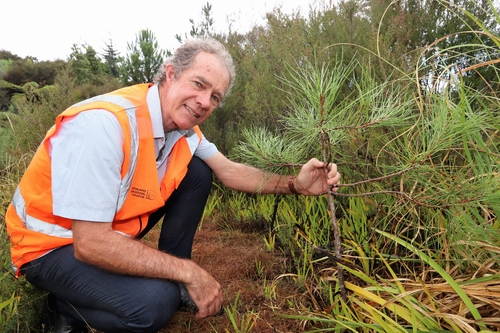Call to tackle wilding conifer spread in Northland
4 Feb 2019, 2:01 PM
The increasing impact wilding conifers are having on Northland’s coastal margins, dune lakes and rare gumland ecosystems has prompted local authority calls for the regional stakeholder group to address the issue.
The Northland Regional Council (NRC) is driving the push for the group’s formation suggesting it would be well-placed – with assistance from Landcare Research – to fully assess the extent and impact wilding conifers are having on the North.
 Biosecurity Manager Don McKenzie with a wilding conifer just off the roadside on Whangarei’s Mt Parihaka. The regional council is keen to see a regional stakeholder group formed to examine wilding conifers and their impacts in Northland.
Biosecurity Manager Don McKenzie with a wilding conifer just off the roadside on Whangarei’s Mt Parihaka. The regional council is keen to see a regional stakeholder group formed to examine wilding conifers and their impacts in Northland.
Council Biosecurity Manager Don McKenzie says wilding conifers have long been an issue in Northland, many of them the descendants of escapees from commercial forestry plantations or shelter belt plantings decades ago.
However, he stresses the council is not looking to blame or penalise commercial foresters or other landowners for the issue; “What we’re saying is ‘right tree, right place, right purpose.”
He says the regional council does have rules requiring control of wilding pines along property boundaries – but not wider controls for the trees – in its Northland Regional Pest and Marine Pathways Management Plan 2017-2027.
He says wilding conifers can comprise several species; cedars, pines (including pinus radiata), firs, cypress, larches, and spruces. While the impacts of wilding conifers in the South Island are well-known and understood – and have attracted significant control funding in recent years – the situation in Northland is less-clear.
“We know from our staff’s own observations in the field, and our examination of recent aerial imagery, that wilding pines are having an increasing, and unwanted, impact on our coastal margins, dune lakes and rare gumland ecosystems.”
He says the problem appears to be worsening with wilding pines slowly increasing their reach and scale, especially in places like the Ngunguru Sandspit and dune lakes in both the Far North are and the Kaipara District, including the Kai Iwi Lakes system.
“Wilding conifers are an issue because not only do they colonise and change the existing environment, displacing native species, they can adversely impact on water tables. Roadside wilding conifers can also be problematic for power and other infrastructural companies, costing them significant sums to trim and remove to protect that infrastructure from potential tree-related damage.”
Northland’s sub-tropical climate also appears to be especially favourable to the conifers, which are typically unwanted commercially because their poor form and heavy branches result in low grade logs which have minimal value.
Mr McKenzie says he believes wilding conifers should be attributed the same pest status as other species like wild ginger, given their potential impacts on the region.
On that basis, the NRC was now in the process of convening a regional stakeholder group of key agencies and interests in February to examine the wider wilding conifer issue. It was hoping various parties including local and central government agencies, commercial foresters and iwi would attend.
While it was too early to say with any certainty at this point how much (if any) central government funding could potentially be applied to the wilding conifer issue in Northland, Mr McKenzie says he personally would like to see an investment of about $900,000 annually over the next decade or so.
“That level of funding would certainly allow us to make reasonable in-roads into addressing any local wilding conifer issues.”
Meanwhile, he says it is also possible that an upcoming scientific paper examining New Zealand’s wilding conifers could be of value to Northland going forward.
